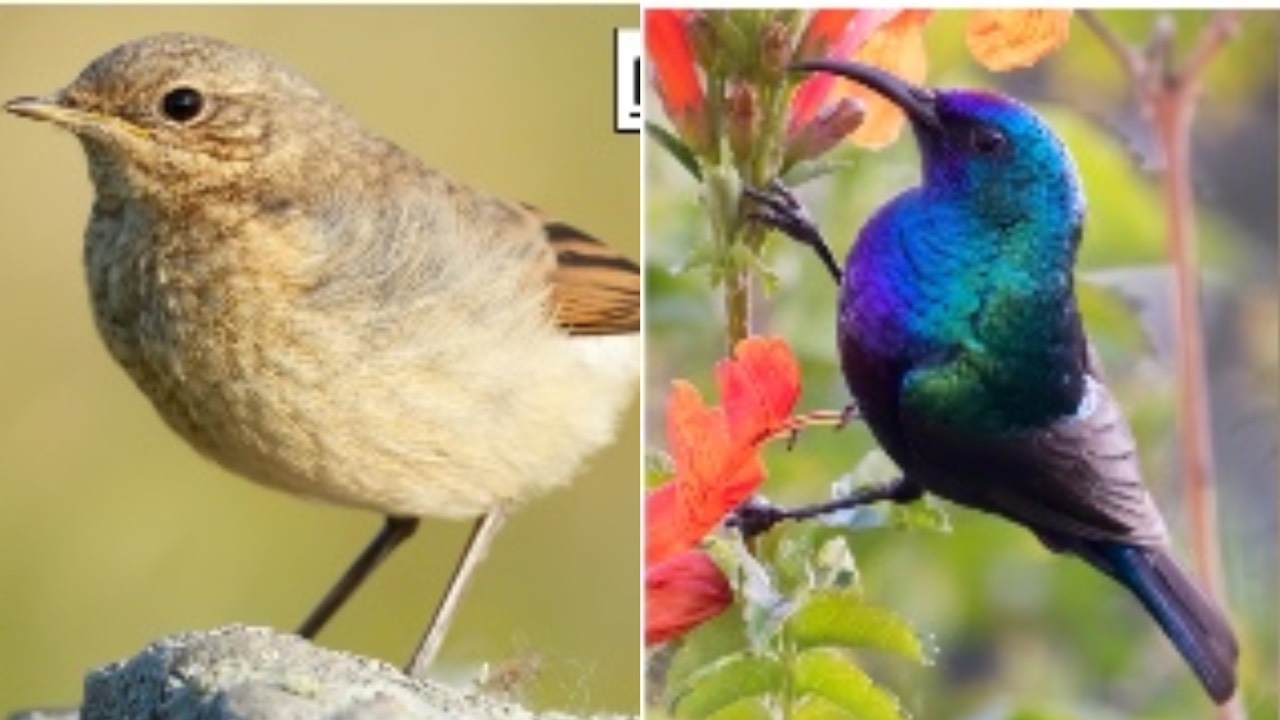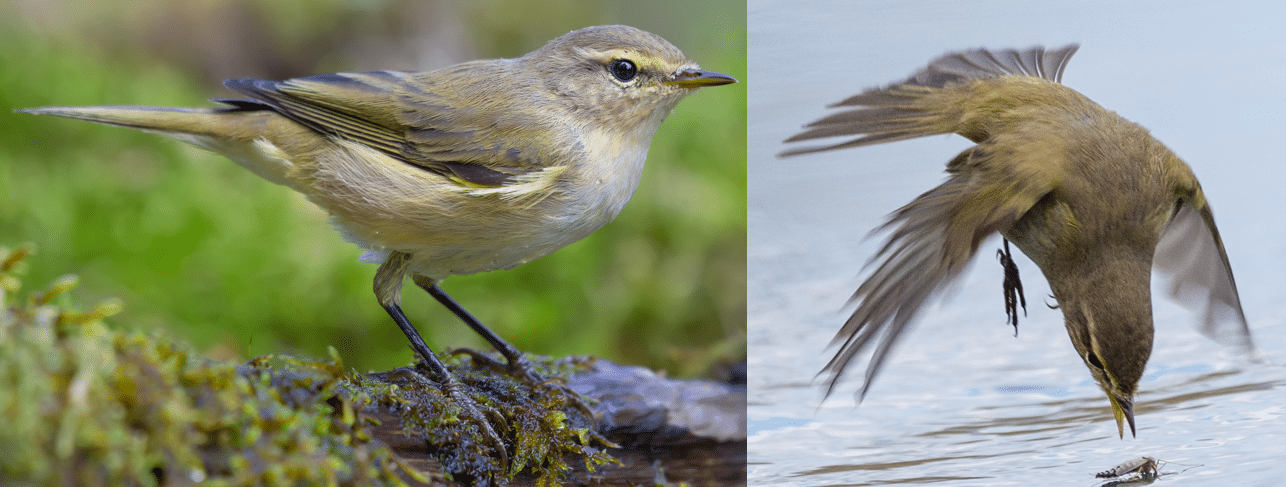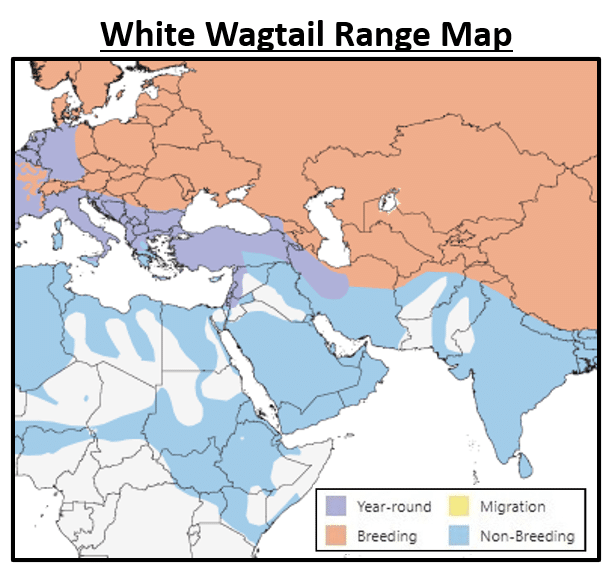

If so, you’ve come to the right place!
Due to the sheer number of species, there was no way to include EVERY bird in the Middle East in this article. So instead, I tried to focus on the birds that are most regularly seen and observed.
#1. Arabian Babbler

Identifying Characteristics:
- Adults are 26-29 cm (10-11 in) long with a wingspan of 31-33.5 cm (12.2-13.2 in).
- Their coloring is a dusty gray with brown speckles on the head and shoulders.
- They have powerful legs, long tails, and curved beaks.
Arabian Babblers are communal, gregarious birds that do nearly everything in a group. Look for these birds in the Middle East along dry riverbeds with plenty of clear areas. They’ll eat almost anything, including insects, lizards, snakes, plants, and nectar.
One of the most interesting traits of the Arabian Babbler is its affinity for helping other babblers. They’ll even squabble amongst themselves for the chance to help another bird build its nest or feed its babies.
Studies show it may be a status symbol amongst flock members to feed lots of babies, giving that individual social prestige. The more helpful and generous the bird, the higher the status within the flock!
#2. Fire-Fronted Serin

Identifying Characteristics:
- Adults are 11–12 cm (4.3-4.7 in) long.
- Their body coloring is stripey soot-gray and yellow. The head is dark gray with white flecks.
- During the breeding season, they have a patch of bright reddish-orange on the forehead.
The Fire-fronted Serin is named for the bright red patch that colors its forehead. It fades to a rusty brown during the non-breeding season, but the patch is visible year-round.
You can find these beautiful birds in mountainous regions with plenty of trees. In fact, it most commonly lives 1.5-4 km (1-2.5 miles) above sea level, half the height of Mount Everest.
Fire-fronted Serins are primarily herbivores and live on seeds, flower heads, shoots, and berries. However, they will eat the occasional insect, especially during the breeding season when they need extra protein.
This member of the finch family has a sweet voice. Their song can be likened to “twi-ih-ih-ih-ih-ih-ih.”
#3. Rock Bunting

Identifying Characteristics:
- Adults grow up to 16 cm (6.3 in) long.
- Males have a dark gray head with black horizontal stripes, a gray chest, and rusty underparts, with brown-striped backs and wings.
- Females have a similar pattern but are paler in color overall.
Rock Buntings, which are also known as Mountain Buntings, prefer rocky mountainous landscapes, which is how they got their name. Look for this bird in the Middle East perched on rocks, bushes, or outcroppings.
This species eats insects during the breeding season and then switches to seeds, berries, and fruits afterward. They feed almost constantly when active and are often spotted beside roadways gathering food.
Rock Buntings are mostly altitudinal migrants. This means that instead of traveling north and south to find better weather, they travel up and down the mountains! During inclement weather, Rock Buntings will move below the snow line and back up once the weather clears.
Their most common call is a high-pitched “see—see—see—see.”
#4. Common Chiffchaff

Identifying Characteristics:
- Adults are 10–12 cm (3.9–4.7 in) long.
- Their coloring is green-tinged brown on the body and brown on the head, with a light line above the eyes.
Common Chiffchaffs are passerine birds, meaning they perch in trees or bushes. You can often spot them standing on just one leg as they sing and chirrup. Most bird watchers consider this species a member of the LBJs, or “Little Brown Jobs”. In ornithological slang, LBJ refers to any bird that is difficult to distinguish from other birds that look essentially the same.
These small warblers eat mostly insects, including eggs and larvae from moths and butterflies. The most common predator of the Common Chiffchaff are domestic cats. Other predators like hawks, weasels, ferrets, and minks don’t make a serious dent in their numbers.
Despite its name being supposedly modeled after its voice, the Common Chiffchaff’s call sounds more like a high, clear “hee-hee.”
#5. Laughing Dove

Identifying Characteristics:
- Adults are about 25 cm (10 in) long.
- Their coloring is pinkish on the bottom with a lilac-colored head and neck, black eyes, and gray bills.
- Some rufous dots over a largely dark brown chest give it the appearance of wearing a fancy necklace.
Endemic to the Middle East, the Laughing Dove is a small pigeon with a long tail. It spends most of its time walking along the ground, looking for food. 
Laughing Doves are highly territorial and mate for life; otherwise, they are solitary. Look for them in dry areas, savannahs with trees, acacia thickets, and similar environments. Their range is also spreading to more urban areas as they adapt to the presence of humans.
The nest of the Laughing Dove is a rough pile of sticks, stems, and roots. Typically, the male dove gathers the materials, and then the female arranges them. However, sometimes they reuse another bird’s nest, even one of a different species.
Their distinctive sounds make Laughing Doves easy to differentiate from other doves and pigeons.
#6. Crested Lark

Identifying Characteristics:
- Adults are about 17 cm (7 in) tall with a wingspan of 29-38 cm (11-15 in).
- Their coloring is pale tan overall, with dark brown streaks on the head, back, and wings.
- This species has a crest on the head that sets it apart from other larks.
The Crested Lark has 33 subspecies, the most of any bird in the Middle East.
Their names are as varied as their locations, including the North-west Moroccan crested lark, the West Moroccan crested lark, the North Algerian crested lark, the North-east Algerian crested lark, the Northern Nile Valley crested lark, and the Southern Nile Valley crested lark. It seems as if everyone wants to have their own local Crested Lark version! 🙂
Most of their diet is plant material, but they will occasionally eat beetles and insects, and they certainly don’t mind stealing some farmed grains or seeds. In fact, Crested Larks prefer dry, open land areas, such as fields of cereal grains or roadsides. But, oddly enough, it’s also found near human structures and commercial industry locations such as docks, railways, and airports, favoring sandy patches of ground.
The songs of a Crested Lark are varied and complex, from gargling and warbling trills to mimicry of other birds.
#7. Eurasian Magpie

Identifying Characteristics:
- The head, neck, and breast coloring are shiny black with iridescent purple and green highlights.
- Their shoulders, outer wing tips, and belly are all stark white, though the white wing tips are best observed in flight.
- This species’ feathers between the shoulder and wingtips, as well as the tail, can be iridescent blue-green.
Look for Eurasian Magpies in open countryside, meadows, and rocky areas. They avoid dense forests but often visit parks, gardens, and cities. I think Magpies are beautiful with their mix of black, white, and blue coloring, but they can be aggressive around other birds and feeders.
Magpies are one of the most intelligent birds in the Middle East.
They imitate human speech, and they can recognize themselves in a mirror. In addition, they often cooperate to achieve goals, play games together, and even use tools. Most notably, they grieve when a mate dies, singing specialized songs and behaving differently for a while.
Although they mostly produce mimic vocalizations, they have a natural call that sounds like a raspy chuckle.
#8. Common Rosefinch

Identifying Characteristics:
- Adults are 13–15 cm (5.1–6 in) long.
- Males have a dazzling rose-colored head, breast, and rump, with red-tinted dark brown wings, with a pinkish-white, or sometimes all-white, underside.
- Females are yellowish-brown above and buff below.
You may know this bird in the Middle East by its other name, the Scarlet Rosefinch. They like shrubby and brushy areas, hedgerows, forest edges, and clearings. This makes it easy to obtain their preferred food which is seeds. However, they do eat insects for extra protein during the breeding season.
If you want to attract a Common Rosefinch to your bird feeder, try offering millet, fruits, peanuts, and suet during the winter when other food is harder to come by. Those who live close to forests will have the most luck.
Listen for their clear, melodious song that can be likened to “ee-ahh-ooh-ooh.”
#9. Eurasian Collared Dove

Identifying Characteristics:
- The coloring of this species is gray throughout and slightly darker at the back.
- They have a small black horizontal stripe on the back of the neck, outlined in white.
- Their beaks and eyes are black, and their legs are pink to red.
Despite its drab color, the Eurasian Collared Dove is a very interesting bird in the Middle East!
One truly strange feature of the Eurasian Collared Dove is the way it drinks. Unlike most birds that gather water in their beak and tip their head back to drink, this species uses its beak as a straw! It seems unlikely that this large gray bird could have anything in common with a tiny, flashy hummingbird, but they look similar when drinking water.
One of the easiest ways to recognize this species is to listen for its three-note song, which sounds like “coo-coo-coooo.” They also give a warning screech if they land near another bird as if they’re honking a car horn on arrival.
This species is native to Europe but has spread across the world through a series of unlikely events. First, in the mid-1970s, a pet shop in the Bahamas was robbed, and a few Eurasian Collared Doves were released. Then, not long after, more were set free on the island of Guadaloupe during a volcanic eruption. Then, the birds traveled across the globe quickly!
#10. White-Eared Bulbul

Identifying Characteristics:
- Adults are 17.5-19 cm (6.9-8 in) long.
- Their coloring is gray on the body with a black head, black eyes, gray beak, and a brilliant white pair patch on each side of the head.
- The tail is black with white tips, visible from above and below. There is a distinctive yellow patch of feathers under the tail.
White-eared Bulbuls are rather rotund in appearance, but their round body shape gives them an evolutionary advantage. Despite living in some colder regions, this species doesn’t migrate, so instead, they store energy in the form of fat for the colder seasons.
They’re very personable in captivity, making this species a sought-after pet. Unfortunately, the pet trade often does more harm than good. White-eared Bulbuls are taken from the wild and forced into captivity, where they often get sick or die prematurely. Additionally, some of these birds escape into unfamiliar habitats, where they can become invasive and harm natural populations. It’s best to enjoy these birds in their natural habitat.
In the wild, White-eared Bulbuls entertain themselves by tossing objects back and forth with their mate. They also have a pleasant, twittering call that makes them sound very friendly!
Unfortunately, this bird in the Middle East often escapes captivity. They form feral populations that decimate date orchards, so they’ve earned a reputation as a pest species.
#11. Hooded Crow

Identifying Characteristics:
- Adults are 48-52 cm (19-20 in) long with a wingspan of about 105 cm (41 in).
- Their coloring is black over the head, neck, tail, and wings. The back and torso are ashy gray.
The Hooded Crow is one of the most intelligent birds in the Middle East!
They often apply their intelligence to the task of finding food. For example, they drop mollusks and crabs from WAY up high onto rocks to crack the shells open. They even watch other crows hide food, then swoop in and steal it once the other bird flies off!
Additionally, the Hooded Crow recognizes superior building materials. They will use animal bones to reinforce their nest or add pieces of wire instead of sticks. Those nesting near the coast use lengths of seaweed as a rope to tie their nest pieces together. This crafty bird might have a future as an architect! 🙂
This species makes the typical caws, grunts, and wah-wah-wah sounds you probably expect from crows.
#12. Palestine Sunbird

Identifying Characteristics:
- Adults are 8 to 12 cm (3.1-4.7 in) long and only weigh 6.8-7.5 grams (about 1/4 ounce).
- They have glossy black feathers that shine greenish-blue in the sunlight.
- Their black bills are long, thin, and curved downward.
Palestine Sunbirds are often mistaken for hummingbirds in the Middle East.
This is because they are of a similar size, eat nectar and small insects, and hover in flight. But these two birds are only distantly related, as hummingbirds are only found in the western hemisphere, and sunbirds only live in the eastern hemisphere.
This is an example of convergent evolution, where two unrelated species evolve similar traits and characteristics, resulting from having to adapt to similar environments, such as the beaks and tongues of sunbirds and hummingbirds.
Sunbirds and hummingbirds evolved to meet the demands of their environments without being related. For example, their long curved beaks, brush-like tongues, and small bodies allow them to use nectar for energy while they hunt for insects to give them added nutrition.
Palestine Sunbirds are so comfortable around people that they will sometimes build their nests indoors near humans! If you live in this bird’s range during the breeding season, leaving your windows open might invite some unexpected house guests.
Sunbirds have a loud song for such a petite bird; it sounds a bit like “taw-wee, taw-wee, taw-wee.”
#13. Northern Wheatear

Identifying Characteristics:
- Adults are 14.5–16 cm (5.7–6.3 in) long.
- Males are grayish-white over most of their bodies, with a rufous chin and a black stripe over the eye. Their wings are predominantly black.
- Females are mostly rufous, with a brownish back and darker brown wings.
This tiny bird has an impressive travel itinerary!
Every year during migration, the Northern Wheatear makes a record-setting journey, crossing deserts, ice fields, and oceans. The Northern Wheatear spends its winters in the sub-Saharan region of Africa, then travels across the Northern Hemisphere to its remote breeding locations in Asia, Europe, Greenland, Canada, and Alaska. Once autumn rolls around, they again take to the sky and head back to Africa.
Northern Wheatears are about as large as House Sparrows, and no other bird of its size has a comparably long migration route. The total distance covered is 30,000 kilometers (18,641 miles)!
This species’ alarm call is a “chuck-chuk-chuk-TWEE” repeated continuously. On the other hand, their song is an ever-changing mix of warbles, tweets, and chirrups.
#14. Eurasian Kestrel

Identifying Characteristics:
- Adults are 32–39 cm (12.5–15.5 in) long with a wingspan of 65–82 cm (25.5–32.5 in).
- Their coloring is ruddy brown and black, often with a checkerboard pattern on the back and wings.
- Males have a slate-blue head and white chin.
- Both sexes have bright yellow legs and eye-rings and large black eyes.
This bird of prey in the Middle East is a member of the falcon family.
The Eurasian Kestrel uses three distinct hunting techniques. First is the hover approach, where they face the wind and float in the air, using their keen eyesight to spot prey. Second is the ridge flight, using updrafts to provide lift as they coast along effortlessly, which helps them cover a lot of territory with very little effort.
The third hunting technique conserves even more energy. They post themselves on an overhanging tree limb and survey the immediate vicinity. Then, they perform a steeply-pitched dive when they spot prey, grabbing it from the ground. Their diet is almost exclusively voles, mice, and shrews.
Eurasian Kestrels are very vocal in flight, and their call is a “chit-chit-chit” sound.
#15. White Spectacled Bulbul

Identifying Characteristics:
- Adults are 20–25 cm (7.9–9.8 in) long with a wingspan of 20–25 cm (7.9–9.8 in).
- Their coloring is mostly white, mottled with light brown. The head and face are black, and they have brilliant yellow feathers under the black tail.
- This species has white eye rings, which is how it got its common name.
Look for the White Spectacled Bulbul in suburban gardens, populated cities, and on fruit plantations. Breeding populations of this bird in the Middle East prefer areas with plenty of trees since they use leaves and twigs to build their nests.
This agile bird feeds most often at dusk when it takes flight and snatches insects right out of the air. They supplement their insect diet with berries, fruit, and seeds.
Their call is a reedy “whee-too-too.”
#16. Great Tit

Identifying Characteristics:
- A yellow belly with a distinctive black stripe running right down the middle of its chest, a jade back, and a black cap and collar contrasting with its white cheek patches.
- Its wings are grey-brown with a flashy lateral white-yellow bar, and the tail is a black fan.
The Great Tit is one of the most recognizable birds in the Middle East.
They live in mixed forests, clearings, and dense woodlands. They have a particular affinity for people, and you’ll often find them in parks, gardens, cultivated fields, and even cities.
Despite living in particularly cold regions, most Great Tits don’t migrate as the weather changes. Instead, they have physical adaptations that help them survive cold winters. For example, this species can warm its internal body temperature in response to cold weather. They actually change their blood chemistry, creating more heat by producing more red blood cells during the winter!
In addition, these fascinating birds are able to control how much heat escapes their body by insulating from within. The blood vessels in the skin, beaks, and feet constrict, keeping the warm blood closer to their cores, and allowing them to stay toasty warm.
The Great Tit has over 70 songs and vocalizations! This is because there are so many different calls to choose from; compilations are available to familiarize yourself with common examples.
#17. Mallard
Identifying Characteristics:
- Males have a bright green head, thin white collar, dark reddish-brown chest, yellow bill, and a black rump with a white-tipped tail.
- Females are mottled brown with orange and brown bills.
- Both sexes have purple-blue secondary feathers on their wings, most visible when standing or flying.
My guess is that almost everyone is familiar with the Mallard. These birds are one of the most common ducks in the Middle East!
Mallards are extremely comfortable around people, which is why these adaptable ducks are widespread. They are found in virtually any wetland habitat, regardless of location.
When you think of a duck quacking, it is almost inevitably a female Mallard. If there is a better duck sound, we haven’t heard it! Interestingly, males do not quack like females but make a raspy call instead.
#18. Eurasian Blackbird

Identifying Characteristics:
- Males are entirely black with a bright yellow ring around their eyes. The beak is bright orange.
- Females and juveniles are mottled browns with yellowish-brown beaks. However, they still have a bright yellow eye ring.
The Eurasian or Common Blackbird is one of the most recognizable birds in the Middle East. Their preferred territories include gardens, wooded habitats, parks, and farmland with hedges. Look for them on lawns and fields, where they spend most of their time foraging insects and earthworms.
Like many blackbirds, this species is extremely territorial, especially during breeding. Look for squabbles and fights to break out regularly over food, nesting locations, and seemingly nothing!
Listen for the Eurasian Blackbird’s multi-toned warbling cry, which is easy to recognize, but harder to describe.
#19. Little Egret

Identifying Characteristics:
- Adults are 55–65 cm (22–26 in) long with an 88–106 cm (35–42 in) wingspan.
- They are white with black bills and legs and yellow eyes and feet.
- Their necks have a strong “S” curve and a thin tuft of long feathers on the head.
These aquatic birds in the Middle East are almost always found near water.
Look for Little Egrets along coastlines and larger inland waterways like lakes and rivers. They catch fish, crustaceans, and insects directly from the water while standing in the shallows or flying over the surface.
The population of the Little Egret has been threatened by overhunting not once but twice throughout history. First, during the Middle Ages, this species was hunted for food to near extinction. Then in the late 1800s, Little Egrets were threatened once more by overhunting for their feathers.
Luckily, they have since been protected by conservation laws and are now considered a species of least concern. It’s got to be persistent to have survived all that!
#20. Barn Swallow

Identifying Characteristics:
- Small bird with a flat head, thin bill, pointed wings, thick neck, and fork-like tail.
- Both sexes are similar – striking royal blue back, rusty brown underparts, with a rufous colored forehead and throat. White spots on the tail are typically visible during flight.
These birds are typically found in the Middle East in open fields, meadows, pond marshes, or coastal waters.
Barn Swallows prefer to eat larger insects rather than eating groups of smaller ones. They primarily feed close to water or the ground catching insects in midair. This bird doesn’t typically ever come to bird feeders. But you may get lucky if you leave out eggshells or oyster shells on a platform feeder. These foods aid in their digestion.
One interesting fact about Barn Swallows is sometimes an unmated male will kill young birds in a nest to break up the parenting Barn Swallow couple. Then the unmated male gets together with the female. Talk about a complicated love triangle! 🙂
Both males and females sing a song of warbling notes and mechanical sounds. Listen below.
#21. Common Hoopoe

Identifying Characteristics:
- Adults are 25–32 cm (9.8–12.6 in) long with a wingspan of 44–48 cm (17–19 in).
- Its coloring is cinnamon-brown on the head and body, with black and white barred wings.
- The head is adorned with a crest of brown feathers tipped in black.
Look for the Common Hoopoe in rural gardens, cities, plantations, savannas, and grasslands. They often spend time near piles of rotting leaves or a fallen log, where insects, grubs, and worms will use it as a habitat. It’s like a buffet for the Hoopoe!
This unusual-looking bird has a variety of defensive tactics. Its movable crest is used for advertising and intimidating potential predators and rival Hoopoes. If that doesn’t work, this species is ready for a fight! They use their strong head and neck muscles to gouge their long, pointed beaks into opponents’ eyes, which can blind them.
In addition to their fighting skill and intimidating looks, they produce a substance that smells of rotting meat. They cover themselves and their eggs with the substance to warn away predators. Nestlings even have their own scent gland that makes them unappetizing to predators.
#22. Black Kite

Identifying Characteristics:
- Adults are 48-60 cm (19-24 in) long with a wingspan of about 150 cm (59 in).
- Their coloring is dark brown to brownish red, with a white face.
- The legs are yellow, and the hooked beak is black with yellow at the base.
Although its name suggests a mostly black colored species, the Black Kite is generally dark brown to reddish. It’s easy to mistake this bird in the Middle East for other birds of prey, so look closely when identifying!
Black Kites are graceful fliers, soaring over water and open land. They’re adept at catching their prey but will also occasionally eat carrion (road-kill). This species can hunt on the ground and from the air, in addition to visiting garbage dumps looking for edible trash.
This species has a lonely, whistling call that might remind you of a Red-tailed Hawk.
#23. House Sparrow

Identifying Characteristics:
- Males have gray crowns, black bibs, white cheeks, and chestnut on the sides of their faces and neck. Their backs are predominantly brown with black streaks.
- Females are a dull brown color with streaks of black on their backs. Their underparts are light brown. They can be distinguished by the tan line that extends behind their eye.
House Sparrows are native to the Middle East but are now one of the world’s most abundant and widespread birds!
In most urban and suburban areas, it’s INCREDIBLY COMMON to see House Sparrows. They owe their success to their ability to adapt and live near humans. Unlike most other birds, they love grains and are commonly seen eating bread and popcorn at amusement parks, sporting events, etc. At your bird feeders, they especially love eating cracked corn, millet, and milo.
House Sparrows can be heard across the entire planet. In fact, pay attention the next time you’re watching the news in another country. Listen for a simple song that includes lots of “cheep” notes.

Identifying Characteristics:
- A plump bird with a small head, short legs, and a thin bill.
- The typical pigeon has a gray back, a blue-grey head, and two black wing bars. But their plumage is highly variable, and it’s common to see varieties ranging from all-white to rusty brown.
Rock Pigeons are extremely common birds in the Middle East but are almost exclusively found in urban areas.
These birds are what everyone refers to as “pigeons.” You have probably seen them gathering in huge flocks in city parks, hoping to get some birdseed or leftover food tossed their way.
Love them or hate them, Rock Pigeons have been associated with humans for a long time! Some Egyptian hieroglyphics suggest that people started domesticating them over 5,000 years ago. And because of these facts, scientists aren’t even sure where their original range was.
These birds are easy to identify by sound. My guess is that you will already recognize their soft, throaty coos. (Press PLAY below)
#25. Common Chaffinch

Identifying Characteristics:
- Males are rust-colored, with green on the upper back. They have a gray cap that curls around the back of their head, surrounding the earhole, and looks like a shirt collar.
- Females are duller with a greenish-brown head, white tail feathers, and a green posterior.
- Both sexes have bright white stripes on their wings.
Common Chaffinches are incredibly common, mostly because they are so adaptable. Look for this small songbird in the Middle East in many habitats, such as forests, parks, and neighborhoods with lots of tree cover.
Chaffinches are incredibly common at bird feeders. They are most often seen on the ground cleaning up the seed that has fallen from above, with sunflower hearts being their favorite. These birds can become so tame in backyards that they flutter around people as they come outside, expecting to be fed or the feeders refilled!
Their song is so beautiful that a group of these birds is known as a “Charm!” Their songs usually contain a rattling series of notes that start high and lower toward the end.
#26. White Wagtail

Identifying Characteristics:
- Adults are 16.5-19 cm (6.4-7.4 in) long.
- Their coloring is black, white, and dull gray. Their white face and black throat are the most noticeable features.
- This species has long legs, a puffed chest, and a rounded head.
White Wagtails are common across Eurasia, but incredibly, this little guy sometimes ventures all the way to western Alaska for nesting.
This species falls victim to the Common Cuckoo, a brood parasite that lays its eggs in the host’s nest. Usually, a host bird is forced to care for the cuckoo chick, but not White Wagtails. Since they are too small to destroy the eggs, they often abandon an invaded nest and start over.
The White Wagtail got its name from the way it forages along the water’s edge, wagging its tail, looking for insects. They mostly hunt on land but will pursue prey in the air occasionally. Sometimes they wade in shallows or walk atop floating masses of vegetation while on the hunt. Likely prey includes crane flies, midges, mayflies, and aquatic larvae.
Its call is an extremely short and fast pair of high-pitched “chirrups.”
#27. Common Myna

Identifying Characteristics:
- Adults are 23 cm (9 in) long.
- They have thick yellow legs, a yellow-tipped bill, and a yellow patch of skin underneath their eyes.
- Their plumage is glossy black on the head with a brown body and lighter undercarriage. The undersides of their wings are pure white.
The Common Myna is one of only three birds worldwide to make the “100 Most Invasive Species” list! Although the reasons are complex, the IUCN Species Survival Commission stated that it poses “a threat to biodiversity, agriculture, and human interests.”
The main problem with the Common Myna is that it will eat basically anything, meaning it can outcompete native species and decimate their numbers. They readily devour the chicks and eggs of other birds, lizards, fruits, beetles, and their larvae, spiders, snails, flies, worms, and caterpillars.
But, as the saying (sort of) goes, one man’s invasive pest is another Farmer’s Friend. At least, that’s what this species is called in India, where it eats insects that damage crops, like grasshoppers and locusts. 🙂
This species doesn’t just eat all day either – their extreme vocal range makes for a noisy day anytime they’re around. They can growl, croak, chirp, squawk, whistle, and click. The Common Myna can even mimic human speech!
#28. White Stork

Identifying Characteristics:
- Adults are 100–115 cm (39–45 in) tall with a wingspan of 155–215 cm (61–85 in).
- They are white overall with black wing edges and red legs and bills.
Look for White Storks in open, grassy meadows in the Middle East.
Interestingly, White Storks avoid traveling over water during migration and instead migrate over land, even when it’s a less direct route. This is because they’re a soaring species, and they need to stay over land to take advantage of air currents that help them glide.
You’ve probably heard the tale that storks bring babies to parents-to-be. It’s amazing how far back in history this legend goes! As long ago as during the empire of Ancient Rome, storks were seen as parental figures and good omens to families. A Hans Christian Andersen story called “The Storks” from the 19th century popularized the idea of baby delivery. 🙂
Which of these birds in the Middle East have you seen before?
Leave a comment below!

































